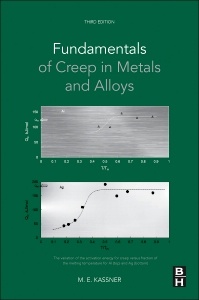Description
Fundamentals of Creep in Metals and Alloys (3rd Ed.)
Author: Kassner Michael E.
Language: English
Subjects for Fundamentals of Creep in Metals and Alloys:
Keywords
γ/γ' Nickel-based superalloys; □; 3-power-law regime; 3-power-law viscous glide creep; 5-power-law; Alloys; Amorphous metals; Bulk metallic glasses; Cavitation; Creep; Creep fracture; Creep plasticity; Creep temperature; Crystalline materials; Diffusional creep; Dynamic recrystallization; Grain boundary; Harper-Dorn creep; Intermetallics; Lamellae; Low-temperature creep; Peierls stress; Plasticity; Recrystallization; Splat cooling; Strain rate; Stress; Superalloys; Superdislocations; Tensile
Approximative price 157.46 €
In Print (Delivery period: 14 days).
Add to cart356 p. · 15.2x22.8 cm · Hardback
Description
/li>Contents
/li>Readership
/li>Biography
/li>Comment
/li>
Although the present edition of Fundamentals of Creep in Metals and Alloys remains broadly up to date for metals, there are a range of improvements and updates that are either desirable, or required, in order to ensure that the book continues to meet the needs of researchers and scholars in the general area of creep plasticity. Besides updating the areas currently covered in the second edition with recent advances, the third edition will broaden its scope beyond metals and alloys to include ceramics, covalent solids, minerals and polymers, thus addressing the fundamentals of creep in all basic classes of materials.
- Numerous line drawings with consistent format and units allow easy comparison of the behavior of a very wide range of materials
- Transmission electron micrographs provide direct insight into the basic microstructure of metals deforming at high temperatures
- Extensive literature review of about 1000 references provides an excellent overview of the field
A. Description of Creep
B. Objectives
2.0 Five-Power-Law Creep
A. Macroscopic Relationships
B. Microstructural Observations
C. Rate-Controlling Mechanisms
D. Other Effects on Five-Power-Law Creep
3.0 Diffusional Creep
4.0 Harper Dorn Creep
A. The Size Effect
B. The Effect of Impurities
5.0 Three-Power-Law Viscous Glide Creep
6.0. Superplasticity
A. Introduction
B. Characteristics of Fine Structure Superplasticity
C. Microstructure of Fine Structure Superplastic Materials
D. Texture Studies in Superplasticity
E. High Strain Rate Superplasticity (HSRS)
F. Superplasticity in Nano and Submicrocrystalline Materials
7.0 Recrystallization
A. Introduction
B. Discontinuous Dynamic Recrystallization (DRX)
C. Geometric Dynamic Recrystallization
D. Particle Stimulated Nucleation (PSN)
E. Continuous Reactions
8.0 Creep Behavior of Particle Strengthened Alloys
A. Introduction and Theory
B. Small Volume Fraction Particles That Are
Coherent and Incoherent with Small Aspect Ratios
9.0 Creep of Intermetallics
A. Introduction
B. Titanium Aluminides
C. Iron Aluminides
D. Nickel Aluminides
10.0 Creep Fracture
A. Background
B. Cavity Nucleation
C. Growth
- Numerous line drawings with consistent format and units allow easy comparison of the behavior of a very wide range of materials
- Transmission electron micrographs provide direct insight into the basic microstructure of metals deforming at high temperatures
- Extensive literature review of about 1000 references provides an excellent overview of the field




